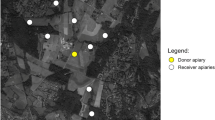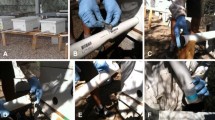Abstract
Movements of the parasitic honey bee mite,Varroa jacobsoni (Oud.) were monitored in several assays as they moved among adult host honey bees,Apis mellifera. We examined the propensity of mites to leave their hosts and to move onto new bee hosts. We also examined their preference for bees of different age and hive function. Mites were standardized by selecting mites from newly emerged worker bees (NEWs). In closed jars, 50% ofVarroa left NEWs irreversibly when no physical path was present for the mites to return to the NEWs; about 90% of mites left newly emerged drones in identical assays. In petri dish arenas, mites were rarely seen off NEW hosts when monitored at 15-min intervals for 4 h; this was the case for single NEWs with one mite (NEWs+) and when a NEW+ and a NEW− (no mites) were placed together in a petri dish. When a NEW+ was held with either a nurse beeor a pollen forager, 25% of the mites moved to the older bees. When both a nurseand a pollen forager were placed in a petri dish with a NEW+, about 50% of the mites transferred to older bees; nurse bees received about 80% of these mites, whereas pollen foragers received significantly fewer mites (about 20%,P < 0.05). Most mite transfers occurred during the first 30 min after combining NEWs+ and test bees. When NEWs+ were combined with bees of known ages, rather than function, mites transferred more often to young bees than to older bees (1- and 5-day-old bees vs. 25-day-old bees,P < 0.05; 1-day-old vs. 13- and 25-day-old bees;P < 0.05). No differences in proportions of transferring mites were seen when the range of bee ages was ≤ 8 days (P > 0.05), implying that the factors mediating the mites’ adult-host preference change gradually with bee age. A possible chemical basis for host choice byVarroa is indicated by their greater propensity to move onto freezer-killed nurse bees than onto freezer-killed pollen foragers (P < 0.05) and by their lower movement onto heat-treated bees than onto control bees (P < 0.05). Bee age, hive function, and directional changes in cuticular chemistry are all correlated. Movements of newly emerged mites in relation to these variables may provide insights into their reproductive success inApis mellifera colonies.
Similar content being viewed by others
References
Boot, W. J., Calis, J. N. M., and Beetsma, J. (1991). Invasion ofVarroa mites into honeybee brood cells; When do brood cells attractVarroa mites?Proc. Exp. Appl. Entomol. N.E.V. Amsterdam 2: 154–156.
Boot, W. J., Calis, J. N. M., and Beetsma, J. (1992). Differential periods ofVarroa mite invasion into worker and drone cells of honey bees.Exp. Appl. Acarol. 16: 295–301.
Crane, E. (1988). Africanized bees, and mites parasitic on bees, in relation to world beekeeping. In Needham, G. R., Page, R. E., Jr., Delfinado-Baker, M., and Bowman, C. E. (eds.),Africanized Honey Bees and Mites, Ellis Horwood, John Wiley and Sons, New York.
Delfinado-Baker, M. (1988). Variability and biotypes ofVarroa jacobsoni Oudemans.Am. Bee J. 128: 567–568.
Delfinado-Baker, M., Rath, W., and Boecking, O. (1992). Phoretic bee mites and honeybee grooming behavior.Int. J. Acarol. 18(4): 315–322.
De Ruijter, A. (1987). Reproduction ofVarroa jacobsoni during successive cycles of the honey bee.Apidologie 18: 321–326.
Donzé, G., and Guerin, P. M. (1994). Behavioral attributes and parental care ofVarroa mites parasitizing honey bee brood.Behav. Ecol. Sociobiol. 34: 305–319.
Francis, B. R., Blanton, W. E., Littlefield, J. L., and Nunamaker, R. A. (1989). Hydrocarbons of the cuticle and hemolymph of the adult honey bee (Hymenoptera: Apidae).Ann. Entomol. Soc. Am. 82: 486–494.
Greatti, M., Milani, N., and Nazzi, F. (1992). Reinfestation of acaricide-treated apiary byVarroa jacobsoni Oud.Exp. Appl. Acarol. 16: 279–286.
Griffiths, D. A., and Bowman, C. E. (1981). World distribution ofVarroa jacobsoni, a parasite of honeybees.Bee World 62: 154–163.
Hoppe, H., and Ritter, W. (1988). The influence of the Nasanov pheromone on the recognition of house bees and foragers byVarroa jacobsoni.Apidologie 19(2): 165–172.
Jay, S. C. (1963). The development of honeybees in their cells.J. Apic. Res. 2: 117–134.
Kraus, B. (1993). Preferences of the bee parasiteVarroa jacobsoni for bees of different ages.J. Apic. Res. 32(2): 57–64.
Kraus, B., Koeniger, N., and Fuchs, S. (1986). Unterscheidung zwischen Bienen verschiedenen Alters durchVarroa jacobsoni Oud. und Bevorzungung von Ammenbienen im Sommerbienenvolk.Apidologie 17(3): 257–266.
Le Conte, Y., and Arnold, G. (1988). Etude de thermopréférendum deVarroa jacobsoni Oud.Apidologie 19(2): 155–164.
Le Conte, Y., Arnold, G., Trouiller, J., Masson, C., Chappe, B., and Ourisson, G. (1989). Attraction of the parasitic miteVarroa to the drone larvae of honey bees by simple aliphatic esters.Science 245: 638–639.
Le Conte, Y., Arnold, G., and Desenfant, P. H. (1990). Influence of brood temperature and hygrometry variations on the development of the honey bee ectoparasiteVarroa jacobsoni (Mesostigmata: Varroidae).Environ. Entomol. 19(6): 1780–1785.
Mikawa, F. (1986). A study on the extermination ofVarroa jacobsoni. InProceedings of the XXXth International Apicultural Congress of Apimondia, Japan, 1985, Takizawa Shinbun Printing, Tokyo.
Phelan, P. L., Smith, A. W., and Needham, G. R. (1992). Mediation of host selection by cuticular hydrocarbons in the honeybee tracheal miteAcarapis woodi (Rennie).J. Chem. Ecol. 17(2): 463–473.
Rickli, M., Guerin, P. M., and Diehl, P. A. (1992). Palmitic acid released from honeybee worker larvae attracts the parasitic miteVarroa jacobsoni on a servosphere.Naturwissenschaften 79: 320–322.
Ritter, W. (1988).Varroa jacobsoni in Europe, the tropics, and subtropics. In Needham, G. R., Page, R. E., Jr., Delfinado-Baker, M., and Bowman, C. E. (eds.),Africanized Honey Bees and Mites, Ellis Horwood, John Wiley and Sons, New York.
Sakofski, F., and Koeniger, J. (1988). Natural transfer ofVarroa jacobsoni among honeybee colonies in autumn. In Cavalloro, R. (ed.),European Research on Varroatosis Control, A. A. Balkema, Rotterdam, The Netherlands, pp. 81–83.
Sakofski, F., Koeniger, J., and Fuchs, S. (1990). Seasonality of honey bee colony invasion byVarroa jacobsoni Oud.Apidologie 21: 547–550.
Seeley, T. D. (1985).Honeybee Ecology: A Study of Adaptation in Social Life, Princeton University Press, Princeton, NJ.
Sheppard, W. S. (1989a). A history of the introduction of honey bee races into the United States. Part I.Am. Bee J. 129: 617–619.
Sheppard, W. S. (1989b). A history of the introduction of honey bee races into the United States. Part II.Am. Bee J. 129: 664–667.
Sokal, R. R., and Rohlf, F. J. (1981).Biometry, 2nd ed., W. H. Freeman, New York.
Takeuchi, K., and Sakai, T. (1986). Possible combination of three control measures for Varroasis. InProceedings of the XXXth International Apicultural Congress of Apimondia, Japan, 1985, Takizawa Shinbun Printing, Tokyo.
Tanabe, Y., and Tamaki, Y. (1986). Biochemical genetic studies onApis mellifera andApis cerana. InProceedings of the XXXth International Apicultural Congress of Apimondia. Japan, 1985, Takizawa Shinbun Printing, Tokyo.
Winston, M. L. (1987).The Biology of the Honey Bee, Harvard University Press, Cambridge. MA.
Author information
Authors and Affiliations
Rights and permissions
About this article
Cite this article
Kuenen, L.P.S., Calderone, N.W. Transfers ofVarroa mites from newly emerged bees: Preferences for age- and function-specific adult bees (Hymenoptera: Apidae). J Insect Behav 10, 213–228 (1997). https://doi.org/10.1007/BF02765554
Received:
Revised:
Issue Date:
DOI: https://doi.org/10.1007/BF02765554




